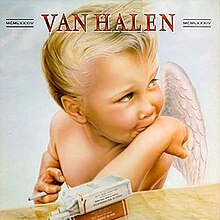1984 (Van Halen album)
| 1984 | ||||
|---|---|---|---|---|
 |
||||
| Studio album by Van Halen | ||||
| Released | January 9, 1984 (US) February 10, 1984 (UK) |
|||
| Recorded | 1983 | |||
| Studio | 5150 Studios in Studio City, CA | |||
| Genre | Hard rock, heavy metal, glam metal, synthrock | |||
| Length | 33:17 | |||
| Label | Warner Bros. | |||
| Producer | Ted Templeman | |||
| Van Halen chronology | ||||
|
||||
| Singles from 1984 | ||||
|
||||
| Professional ratings | |
|---|---|
| Review scores | |
| Source | Rating |
| AllMusic | |
| Robert Christgau | B+ |
| Rolling Stone | |
1984 (stylized as MCMLXXXIV on the album's front cover) is the sixth studio album by American hard rock band Van Halen, released on January 9, 1984. This album and their debut are Van Halen's bestselling albums, each having sold more than 10 million copies.1984 was the last Van Halen album to feature lead singer David Lee Roth until 2012's A Different Kind of Truth, and the final full-length album with all four original members. Roth left the band in 1985 due to increasing creative differences.
1984 was well-received by music critics. Rolling Stone ranked the album number 81 on its list of the 100 Greatest Albums of the 1980s. Commercially, the album went on to reach number two on the Billboard 200 album chart and remained there for five weeks, behind Michael Jackson's Thriller (where Eddie Van Halen made a guest performance). 1984 produced four singles, including "Jump", Van Halen's only number one single on the Billboard Hot 100; the top-20 hits "Panama" and "I'll Wait"; and the MTV favorite "Hot for Teacher". The album was certified Diamond by the Recording Industry Association of America in 1999.
Following the group's 1982 album, Diver Down, Eddie Van Halen was dissatisfied by the concessions he had made to Van Halen frontman David Lee Roth and producer Ted Templeman. Both discouraged Eddie from making keyboards a prominent instrument in the band's music. In 1983, Eddie built his own studio in his backyard, naming it 5150 (after the Los Angeles police code for "escaped mental patient"). At 5150, Eddie composed Van Halen's follow-up to Diver Down—without as much perceived "interference" from Roth or Templeman. The result was a compromise between the two creative factions in the band—a mixture of keyboard-heavy songs, and the intense rock for which the band had become known.
...
Wikipedia
